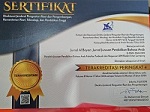Implementation of Neuroscience-Based Multiple Intelligences Theory: To Improve the Intelligence of Students in Ma'had
Abstract
Keywords
Full Text:
PDFReferences
Aase, Ingvild, Johannes Hendrik Langeveld, Jan Olav Johannessen, Inge Joa, Ingvild Dalen, and Wenche ten Velden Hegelstad. “Cognitive Predictors of Longitudinal Positive Symptom Course in Clinical High Risk for Psychosis.” Schizophrenia Research: Cognition 26 (2021): 1-7. https://doi.org/10.1016/j.scog.2021.100210.
Abu Bakar Shiddiq. “The Application of « Nemo » Artificial Intelegence in Arabic Language Learning in the 4.0 Revolution Era at Al-Khalifah Islamic Boarding School Cibubur.” Ijlecr - International Journal of Language Education and Culture Review 6, no. 1 (2020): 58–61. https://doi.org/10.21009/ijlecr.061.07.
Ahmad, Zainal Arifin. “Pengembangan Model Pembelajaran Bahasa Arab Berbasis Teori Multiple Intelligence.” Al Mahāra: Jurnal Pendidikan Bahasa Arab 1, no. 1 (2015): 1–18. https://doi.org/10.14421/almahara.2015.011-01.
Ahmed, Asad Q. “The Reception of Avicenna’s Theory of Motion in the Twelfth Century.” Arabic Sciences and Philosophy 26, no. 2 (2016): 215–243. https://doi.org/10.1017/S0957423916000023.
Albantani, Azkia Muharom, and Ahmad Madkur. “Musyahadat Al Fidyu: Youtube-Based Teaching and Learning of Arabic as Foreign Language (AFL).” Dinamika Ilmu 17, no. 2 (2017): 291–308. https://doi.org/10.21093/di.v17i2.854.
Alhojailan, Ahmad I. “Developing an Understanding of The Sources of Some Graduate Students’ Perceptions of Academic Writing.” Indonesian Journal of Applied Linguistics 11, no. 2 (2021): 281–291. https://doi.org/10.17509/ijal.v11i2.34265.
Alwishah, Ahmed. “Avicenna on Animal Self-Awareness, Cognition and Identity.” Arabic Sciences and Philosophy 26, no. 1 (2016): 73–96. https://doi.org/10.1017/S0957423915000120.
Amrulloh, Muhammad Afif, and Munirul Ikhwan. “Stylistic of The Qur’an: Reading the Story of Sulaiman.” Arabiyat: Jurnal Pendidikan Bahasa Arab Dan Kebahasaaraban 8, no. 1 (2021): 17–31. http://dx.doi.org/10.15408/a.v8i1.18906.
Argondizzo, Carmen, and Gillian Mansfield. “Wellbeing in Language Learning and Teaching.” CercleS 11, no. 2 (2021): 263–268. https://doi.org/10.1515/cercles-2021-2034.
Bahruddin, Uril, Halomoan, and Mualimin Mochammad Sahid. “Implementation of Hots in Debate Strategy to Improve the Ability of Speaking Arabic Among Students.” Solid State Technology 63, no. 4 (2020): 816–826.
Bloom, Benyamin S. Taksonomy of Educational Objetives. London: Longman Group Ltd., 1979.
Booth, Marilyn. “Zaynab Fawwāz’s Feminist Locutions.” Journal of Arabic Literature 52 (2021): 37–67. https://doi.org/10.1163/1570064x-12341419.
Colmenares, Angel, Xu Yan, and Weiguo Wang. “Determinants in the Forecast of the Gross National Income of China and India from 1952 to 2015.” Journal of Management Science and Engineering 6, (2021): 268–294. https://doi.org/10.1016/j.jmse.2021.06.001.
Creswell, John W. Penelitian Kualitatif & Desain Riset: Memilih Diantara Lima Pendekatan. Yogyakarta: Pustaka Pelajar, 2014.
Desfa, Yusmaliana, Suyadi, Widodo Hendro, and Suryadin Asyraf. “Creative Imagination Base on Neuroscience: A Development and Validation of Teacher’s Module in Covid-19 Affected Schools.” Universal Journal of Educational Research 8, no. 1 (2020): 5849–5858. https://doi.org/10.13189/ujer.2020.082218.
Giaber, Jamal, and Hala Sharkas. “Rendering Translation Studies Terminology from English into Arabic: Identification of Methodology and Assessment of Adequacy.” International Journal of Arabic-English Studies 21, no. 2 (2021): 125–146. https://doi.org/10.33806/ijaes2000.21.2.7.
Hadiyanto, Andy, Cendra Samitri, and Siti Maria Ulfah. “Model Pembelajaran Bahasa Arab Multiliterasi Berbasis Kearifan Lokal di Penguruan Tinggi Negeri.” Hayula: Indonesian Journal of Multidisciplinary Islamic Studies 4, no. 1 (2020): 117–140.
Hustad, Katherine C., Tristan J. Mahr, Phoebe Natzke, and Paul J. Rathouz. “Speech Development between 30 and 119 Months in Typical Children i: Intelligibility Growth Curves for Single-Word and Multiword Productions.” Journal of Speech, Language, and Hearing Research 64, no. 10 (2021): 3707–3719. https://doi.org/10.1044/2021_JSLHR-21-00142.
Luke, Chad, Eric T. Beeson, Raissa Miller, Thomas A. Field, and Laura K. Jones. “Counselors’ Perceptions of Ethical Considerations for Integrating Neuroscience With Counseling.” The Professional Counselor 10, no. 2 (2020): 204–219. https://doi.org/10.15241/cl.10.2.204.
Mishar, Rezki, and Yuni R. Bangun. “Create the EQ Modelling Instrument Based on Goleman and Bar-On Models and Psychological Defense Mechanisms.” Procedia - Social and Behavioral Sciences 115 (2014): 394–406. https://doi.org/10.1016/j.sbspro.2014.02.446.
Noureen, Ghazala, R. N. Awan, and H. Fatima. “Effect of Brain-Based Learning on Achievement of VII Graders in Mathematics.” Journal of Elementary Education 27, no. 2 (2017): 85–97.
Nursyamsiah, Nunung, Hikmah Maulani, and Shofa Musthofa Khalid. “Stylistics of Nida Ilahi and Its Implications in Character Learning.” Jurnal Al Bayan: Jurnal Jurusan Pendidikan Bahasa Arab 13, no. 2 (2021): 353–68. https://doi.org/10.24042/albayan.v13i2.9247.
Nuryana, Zalik, and Suyadi Suyadi. “Character Development Based on Hidden Curriculum at the Disaster-Prone School.” Journal of Education and Learning (EduLearn) 13, no. 2 (2019): 219–225. https://doi.org/10.11591/edulearn.v13i2.10058.
Pereira Soares, Sergio Miguel, Maki Kubota, Eleonora Rossi, and Jason Rothman. “Determinants of Bilingualism Predict Dynamic Changes in Resting State EEG Oscillations.” Brain and Language 223, (2021): 1-13, https://doi.org/10.1016/j.bandl.2021.105030.
Putri, Hesty Maulida Eka, and Muassomah. “Tiktok Application as a Project-Based Arabic Learning Media.” Alsinatuna 7, no. 2 (2020): 139–154.
Ritonga, Mahyudin, Martin Kustati, Meliza Budiarti, Ahmad Lahmi, Musda Asmara, Rahadian Kurniawan, Neli Putri, and Endri Yenti. “Arabic as Foreign Language Learning in Pandemic COVID-19 as Perceived by Students and Teachers.” Linguistics and Culture Review 5, no. 1 (2021): 75–92. https://lingcure.org/index.php/journal/article/view/726.
Rubbo, Priscila, Claudia Tania Picinin, and Luiz Alberto Pilatti. “Innovation and Economic Complexity in BRICS.” Int. J. Knowledge Management Studies 12, no. 1 (2021): 66–79. https://doi.org/10.1504/IJKMS.2021.112222.
Rutgers, Dieuwerke, Michael Evans, Linda Fisher, Karen Forbes, Angela Gayton, and Yongcan Liu. “Multilingualism, Multilingual Identity and Academic Attainment: Evidence from Secondary Schools in England.” Journal of Language, Identity & Education (2021): 1–19. https://doi.org/10.1080/15348458.2021.1986397.
Sari, Dina Merris Maya, and Yudy Prasetyo. “Project-Based-Learning on Critical Reading Course to Enhance Critical Thinking Skills.” Studies in English Language and Education 8, no. 2 (2021): 442–456. https://doi.org/10.24815/siele.v8i2.18407.
Setiyawan, Agung. “Problematika Keragaman Latar Belakang Pendidikan Mahasiswa dan Kebijakan Program Pembelajaran Bahasa Arab.” Arabiyat: Jurnal Pendidikan Bahasa Arab dan Kebahasaaraban 5, no. 2 (2018): 195–213.
Shearer, Branton C. “The Theory of Multiple Intelligences After 40 Years: A Scientific Idea Whose Time Has Come or Gone?” An Interdisciplinary Journal Www.Psychologyandeducation.Net 57, no. 7 (2020): 487–494. http://psychologyandeducation.net/pae/index.php/pae/article/view/74.
Sugiyono. Metode Penelitian Kuantitatif Kualitatif Dan R&D. Bandung: Alfabeta, 2017.
Suyadi, and Hendro Widodo. “Millennialization Of Islamic Education Based on Neuroscience in the Third Generation University in Yogyakarta Indonesia.” QIJIS: Qudus International Journal of Islamic Studies 7, no. 1 (2019): 173–202. https://doi.org/10.21043/qijis.v7i1.4922.
Suyadi, Suyadi, and Sutrisno. “A Genealogycal Study of Islamic Education Science at The Faculty of Ilmu Tarbiyah Dan Keguruan UIN Sunan Kalijaga.” Al-Jami‟ah: Journal of Islamic Studies 56, no. 1 (2018): 28–95. https://doi.org/10.14421/ajis.
Suyadi, Suyadi, Zalik Nuryana, and Niki Alma Febriana Fauzi. “The Fiqh of Disaster: The Mitigation of Covid-19 in the Perspective of Islamic Education-Neuroscience.” International Journal of Disaster Risk Reduction 51, no. 2 (2020): 1–15. https://doi.org/doi.org/10/1016/J.ijdrr.2020.101848.
Suyadi, Suyadi, Zalik Nuryana, and Sutrisno Sutrisno. “The Religion in Higher Education Curriculum Referring to Indonesian Qualification Framework: The Inclusion of Neuroscience and Anti-Corruption Education.” International Journal of Education and Learning 3, no. 1 (2021): 38–44. https://doi.org/10.31763/ijele.v3i1.93.
Suyadi, Suyadi, Zalik Nuryana, Sutrisno, and Baidi. “Academic Reform and Sustainability of Islamic Higher Education in Indonesia.” International Journal of Educational Development 89 (2022):1-11. https://doi.org/10.1016/j.ijedudev.2021.102534.
Suyadi, Suyadi. “Hybridization of Islamic Education and Neuroscience: Transdisciplinary Studies of’Aql in the Quran and the Brain in Neuroscience.” Dinamika Ilmu 19, no. 2 (2019): 237–249. doi: http://doi.org/10.21093/di.v19i2.1601.
Tarvirdizdeh, Zahra, and Vahid Nimehchisalem. “Rhetorical Structure in the Problem Statement Section of Iranian Postgraduate Students’ Research Projects.” Studies in English Language and Education 8, no. 2 (2021): 578–595. https://doi.org/10.24815/siele.v8i2.19118.
Thiele, Jan. “Conceptions of Self-Determination in Fourth/Tenth-Century Muslim Theology: Al-Bāqillānī’s Theory of Human Acts in Its Historical Context.” Arabic Sciences and Philosophy 26, no. 2 (2016): 245–269. https://doi.org/10.1017/S0957423916000035.
Thierry, François. “Arlette Nègre et Le Cabinet Des Médailles.” Arabica 67 (2020): 458–459. https://doi.org/10.1163/15700585-12341583.
Thohir, Muhammad, Samsul Ma’arif, Junaedi, Hisbullah Huda, and Ahmadi. “From Disruption to Mobilization: Ire Teachers’ Perspectives on Independent Learning Policy.” Cakrawala Pendidikan 40, no. 2 (2021): 359–373. https://doi.org/10.21831/cp.v40i2.39540.
Thompson, Gregory A. “Equitable Education and the Language Ideological Work of Academic Language (Introduction to Special Issue on Academic Language).” Language and Education 35, no. 6 (2021): 501–4. https://doi.org/10.1080/09500782.2021.1982964.
Vaughn, Kelly A., My V.H. Nguyen, Juliana Ronderos, and Arturo E. Hernandez. “Cortical Thickness in Bilingual and Monolingual Children: Relationships to Language Use and Language Skill.” NeuroImage 243 (2021):1-11. https://doi.org/10.1016/j.neuroimage.2021.118560.
Zumor, Abdulwahid Qasem Al. “Challenges of Using EMI in Teaching and Learning of University Scientific Disciplines: Student Voice.” International Journal of Language Education 3, no. 1 (2019): 74–90. https://doi.org/10.26858/ijole.v1i1.7510.
DOI: http://dx.doi.org/10.24042/albayan.v14i2.12211
Refbacks
- There are currently no refbacks.
Copyright (c) 2022 Jurnal Al Bayan: Jurnal Jurusan Pendidikan Bahasa Arab
License URL: https://creativecommons.org/licenses/by-nc-sa/4.0
Editorial Office:
Jurnal Al Bayan: Jurnal Jurusan Pendidikan Bahasa Arab, Arabic Education Study Program, Faculty of Education and Teachers Training, Unversitas Islam Negeri Raden Intan Lampung
Jl. Endro Suratmin 1 Sukarame, Bandar Lampung 35131-Indonesia
e-mail: jurnalalbayan@radenintan.ac.id
http://ejournal.radenintan.ac.id/index.php/albayan/index
Jurnal Al Bayan: Jurnal Jurusan Pendidikan Bahasa Arab is licensed under a Creative Commons Attribution-ShareAlike 4.0 International License. p-ISSN 2086-9282 | e-ISSN 2549-1229









